Whenever two pipes need to be joined together, T-DRILL METHOD is the answer.
Tee Forming = Pipe Branching = Collaring
Connecting a branch pipe to a run pipe using the T-DRILL method is also called collaring. As the tee is fabricated from the basic tube, no costly T-pieces are needed. Instead of three joints, there is only one joint!

Download a free guide on how to save a million per year with T-DRILL tube and pipe solutions.
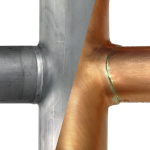
The joint can be completed by brazing (= lap joint) or by welding (butt joint).
Comparing two methods of pipe and tube branching – the traditional way and the T-DRILL METHOD :
COMPARISON: Welded Fittings vs T-DRILL Collaring & Flanging
CUT COSTS, IMPROVE EFFICIENCY, AND SAVE A MILLION PER YEAR WITH T-DRILL METHOD.
Use the calculator to see how much you can save with T-DRILL method.
Tee Forming – The T-DRILL method was developed in the 1970s. The idea that pipes and tubes could be branched much more quickly and cost-effectively into end products of greater strength and higher quality was as revolutionary as it was simple, and one of the major inventions in the field.
As the tee is fabricated from the basic tube, no costly T-pieces are needed. Instead of three joints, there is only one joint! This saves a lot of time and means considerably lower total costs. The construction also makes the tube stronger and provides for better flow characteristics.
Tee Forming – Pipe Branching – Collaring
Pipe branching – i.e., connecting a branch pipe to a run pipe – using the T-DRILL method is also called collaring. The joint can be completed by brazing (= lap joint) or by welding (butt joint).
For the lap joint process, a round hole is drilled in the pipe wall using a collaring head. After the tube wall is penetrated, two forming pins are extended from the drill bit. The collaring head then automatically withdraws from the main run pipe and forms a collar in readiness for the branch tube. The branch tube is located within the collar and finally the joint is completed by brazing. A brazing fixture, a bead or dimple (depth stop), on the tube end ensures that the tube will penetrate to the correct depth on the run tube.
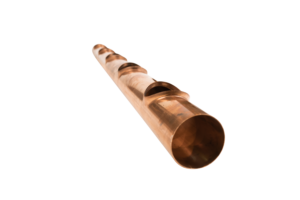
The required collar height (i.e. lapping distance) must be three times the branch tube wall thickness to get the maximum joint strength. Normally lap joints are used on small-diameter tubing applications, such as used in the HVAC, automotive, and other industries.
The time needed for making an outlet using the T-Drill method varies from seconds to minutes, depending on the tube diameter and pipe material used. The complete collaring process is carried out on the outside of the pipe, as opposed to traditional methods in which tools are inserted into the pipe, which makes the tooling difficult to locate when long lengths of pipe are required.
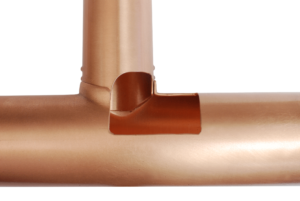
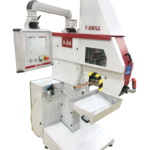 S-56
S-56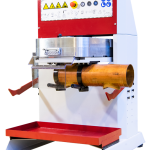 T-115
T-115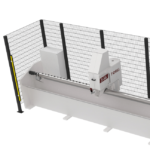 S-56 FBH
S-56 FBH
Most commonly used in:
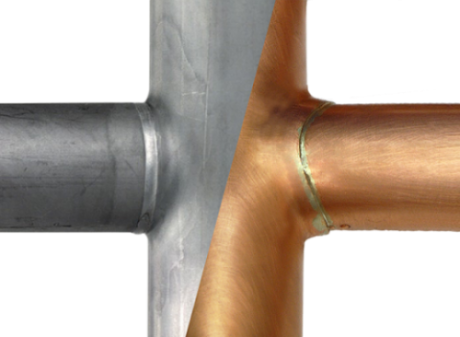
Tee Forming – Pipe Branching – Collaring
The T-DRILL process is a patented method of producing outlets for branch connections. Pipe branching by the T-DRILL method is also called collaring, mechanical tee forming, or simple T-DRILL tees.
Butt welded joint is typically used in the process piping and heavier industrial applications. It provides a better quality inside surface, which is needed, where good flow characteristics and cleanliness are important. The T-DRILL collaring process is a method of producing outlets for branch connections directly from the run material. The process from hole cutting to collar trimming is carried out in a single workstation in one set-up from outside the pipe and no access into the pipe is needed from the end of the pipe.
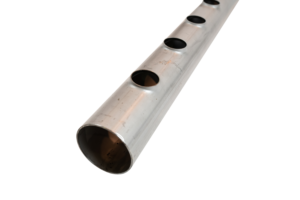
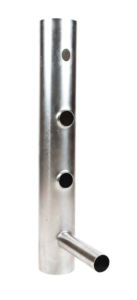
First, an elliptical hole is milled in the pipe. Since more material is needed in the “stirrup” area to get a good collar height for butt welding, an elliptical hole is used as a pilot hole rather than a round hole, which is used in the lap joint. After the pilot hole is made, the forming pins of the collaring head are extended and the collar is formed. This is aided by automated lubrication and optimized forming. Then the collar is trimmed to the desired height and the branch pipe is connected to the run pipe by butt welding.
Typical application areas are in food processing, pharmaceutical, pulp and paper industry, stainless steel piping systems, water treatment, shipbuilding, and conventional and nuclear submarines.
CUT COSTS, IMPROVE EFFICIENCY, AND SAVE A MILLION PER YEAR WITH T-DRILL METHOD.
Use the calculator to see how much you can save with T-DRILL method.
Most commonly used in:
More information about different technologies:
Share on social media